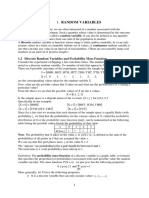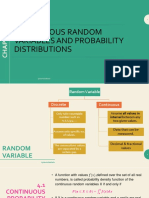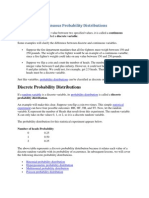Lecture Notes For Class5
Uploaded by
Perry01Lecture Notes For Class5
Uploaded by
Perry01Continuous Random Variables
May 29, 2014
Continuous Random Variables
Before we begin todays lecture, let us discuss an exercise from the
HW:
Components of a certain type are shipped to a supplier in batches
of ten. Suppose that 50% of all such batches contain no defective
components, 30% contain one defective component, and 20% con-
tain two defective components. Two components from a batch are
randomly selected and tested.
What are the probabilities associated with 0, 1, and 2 defective
components being in the batch under each of the following condi-
tions?
a. Neither tested component is defective.
b. One of the two tested components is defective.
Continuous Random Variables
Let B
i
, i 0, 1, 2 be the event that the batch has i defective
components (out of ten).
We know that PpB
0
q .5, PpB
1
q .3, PpB
2
q .2
Let S
i
, i 0, 1, 2 be the event that the sample has discovered i
defective components (out of two).
We will work only part a) -part b) is similar -. What is being asked
in part a) is
PpB
i
|S
0
q ??
As usual, it helps to visualize the partition of the sample space
with the tree of conditional events.
Continuous Random Variables
Figure: The tree of Conditional Events need pruning.
Continuous Random Variables
Figure: The tree, pruned. We need to nd out the unknowns.
Continuous Random Variables
The unknowns are the conditional probabilities PpS
i
|B
j
q. We need
to compute all of them:
For PpS
0
|B
0
q, it is obvious that if there are 0 defective compo-
nents in the batch, there can not be any defective components in
the sample, so it is 1.
For PpS
1
|B
1
q, if there is one defective component the probability
of detecting it in a sample of two is:
9
`
10
2
.2 PpS
1
|B
1
q
Hence, PpS
0
|B
1
q .8.
Continuous Random Variables
For PpS
2
|B
2
q, we have that if there are two defective components
in the Batch, the probability of detecting both in a sample of two
is
PpS
2
|B
2
q
2
10
1
9
.022
(Think of two independent events of nding one defective compo-
nent at a time) similarly,
PpS
0
|B
2
q
8
10
7
9
.622
Hence, PpS
1
|B
2
q 1 .022 .622 .356
We have found all the unknowns in the tree so we can apply Bayes
theorem as usual.
Continuous Random Variables
PpB
0
|S
0
q
PpB
0
XS
0
q
PpS
0
q
PpS
0
|B
0
q PpB
0
q
PpS
0
XB
0
q `PpS
0
XB
1
q `PpS
0
|B
2
q
all this data is by now known and easy to nd in the tree.
We obtain:
PpB
0
|S
0
q
.5
.5 `.24 `.1244
.578
and, by an analogous reasoning:
PpB
1
|S
0
q
.24
.5 `.24 `.1244
.278
PpB
2
|S
0
q
.1244
.5 `.24 `.1244
.144
Continuous Random Variables
A random variable is continuous if both of the following apply:
1. Its set of possible values consists either of all numbers in a sin-
gle interval on the number line, or a disjoint union of intervals.
2. No possible value of the variable has positive probability, that
is, PpX cq 0 for any value c.
Continuous Random Variables
Figure: Example of a continuous r.v Average temperature on the surface
of the earth.
Continuous Random Variables
Problem: In order to obtain Expected Value, Variance etc of an
r.v. we need the weights ppxq.
But, in a continuous r.v. ppxq 0 for all x.
How to solve this? We introduce the concept of probability density
function.
Let X be a continuous rv. Then a probability distribution or prob-
ability density function (pdf) of X is a function f pxq such that for
any two numbers a and b:
Ppa X bq
b
a
f pxq dx
Continuous Random Variables
Example: The current in a certain circuit as measured by an am-
meter is a continuous random variable X with the following den-
sity function:
f pxq
#
.075x `.2 if 3 x 5
0 otherwise
a. Graph the pdf and verify that the total area under the density
curve is indeed 1.
b. Calculate PpX 4q. How does this probability compare to
PpX 4q?
c. Calculate Pp3.5 X 4.5q and also Pp4.5 Xq.
Continuous Random Variables
a.- The pdf is an ane curve. To check that the total mass is in-
deed 1:
5
3
.075x `.2 dx .0375x
2
`.2x
5
3
. . . 1
b.- PpX 4q PpX 4q PpX 4q. Since X is a continuous
r.v. this is zero.
PpX 4q
4
3
.075x `.2 dx . . . .4625
Continuous Random Variables
We have:
f pxq 0 for all x
and
8
8
f pxq dx 1
Constructing pdf of a continuous r.v. for dierent experiments will
be more delicate than in the discrete case. However, there is a
very elementary distribution that we now describe:
Problem: We wish to nd the pdf of a distribution that, given an
interval rA, Bs R, has PprA, Bsq 1, and the probability of any
subinterval depends only in the length of the subinterval.
Continuous Random Variables
Answer: Clearly, one must have f pxq cte. To see exactly which
constant, we recall that PprA, Bsq 1, so
pB Aq cte 1
We call this the uniform distribution supported on rA, Bs. Thus, it
has pdf:
f pxq
#
pB Aq
1
, if x P rA, Bs
0, otherwise
Continuous Random Variables
Example: Suppose the reaction temperature X (in degrees Cel-
sius) in a certain chemical process has a uniform distribution with
A 5 and B 5.
a. Compute PpX 0q.
b. Compute Pp2.5 X 2.5q.
d. For k satisfying 5 k k `4 5, compute
Ppk X k `4q
Continuous Random Variables
Answer: Of course, one can compute the desired probabilities
with the integral of the (constant) density, but it is faster to use
the characterization of the uniform distribution.
Here, the interval where the distribution is supported is r5, 5s, So
Pp5 X 5q 1
Clearly, then,
PpX 0q 1{2 , Pp2.5 X 2.5q 1{2
(since both intervals are of the same length equal to one half of
the length of the supporting interval), and
Ppk X k `4q 0.4
Continuous Random Variables
HW: Section 4.1, 5, 6 ,10
(ans. for 6: b) k 3{4, d) 0.367 , e) .3125)
(ans. for 10: d) p{aq
k
p{bq
k
)
Continuous Random Variables
Question: How to dene the Expected Value and the Variance?
Answer: Recall that ppxq f pxq dx. Hence,
X
ErXs
8
8
x f pxq dx
If hpXq is a function of the r.v. X, then as before we can consider
the r.v. hpXq. Similarly to the discrete case, we have:
ErhpXqs
8
8
hpxq f pxq dx
Continuous Random Variables
As for the Variance:
VrXs E
pX q
2
8
8
px q
2
f pxq dx
As in the discrete case, it measures the average deviation from the
mean
X
of the r.v.
It can be shown, and it is easier to compute:
VrXs ErX
2
s pErXsq
2
Continuous Random Variables
HW: Section 4.2 , 15, 17, 21, 22.
(ans. for 15: b) 0.0107 , e) ErXs .8182, VrXs 0.0124).
(ans for 21: 314.79 m
2
)
(ans for 22: b) median = 1.640 , c) ErXs 1.614, d) 0.061 )
Continuous Random Variables
You might also like
- Laboratory Studies in Integrated Principles of Zoology 18th EditionNo ratings yetLaboratory Studies in Integrated Principles of Zoology 18th Edition54 pages
- Chapter 6 Random Variable and Probability Distribution 115728No ratings yetChapter 6 Random Variable and Probability Distribution 11572824 pages
- BMA2102 Probability and Statistics II Lecture 1No ratings yetBMA2102 Probability and Statistics II Lecture 115 pages
- Discrete and Continuous Random VariablesNo ratings yetDiscrete and Continuous Random Variables26 pages
- WINSEM2024-25_MAT1011_ETH_AP2024254000674_2025-01-22_Reference-Material-INo ratings yetWINSEM2024-25_MAT1011_ETH_AP2024254000674_2025-01-22_Reference-Material-I32 pages
- Continuous Random Variables: He ShuangchiNo ratings yetContinuous Random Variables: He Shuangchi36 pages
- Continuous Random Variable - Definition, Formulas, Mean, ExamplesNo ratings yetContinuous Random Variable - Definition, Formulas, Mean, Examples4 pages
- Chapter 6 - Random Variables and Probability DistributionsNo ratings yetChapter 6 - Random Variables and Probability Distributions101 pages
- Prepared By: Mohammad Saifuddin: Discrete or ContinuousNo ratings yetPrepared By: Mohammad Saifuddin: Discrete or Continuous7 pages
- statatics and probability chapter 3 and 4No ratings yetstatatics and probability chapter 3 and 410 pages
- Lec 11 Probability Density Function (PDF)No ratings yetLec 11 Probability Density Function (PDF)60 pages
- Chapter 4 Continuous Random Variables and Probability Distribution (Part 1)No ratings yetChapter 4 Continuous Random Variables and Probability Distribution (Part 1)17 pages
- Discrete and Continuous Probability DistributionsNo ratings yetDiscrete and Continuous Probability Distributions3 pages
- Department of Mathematics and Statistics: Statistics For Physical Sciences NotesNo ratings yetDepartment of Mathematics and Statistics: Statistics For Physical Sciences Notes41 pages
- Chapter 11 - Continuous Random VariablesNo ratings yetChapter 11 - Continuous Random Variables23 pages
- MODULE+4+ +Continuous+Probability+Distributions+2022+No ratings yetMODULE+4+ +Continuous+Probability+Distributions+2022+41 pages
- Properties of The Trinomial DistributionNo ratings yetProperties of The Trinomial Distribution2 pages
- MAT377 - Combinatorial Mathematics: Stefan H. M. Van ZwamNo ratings yetMAT377 - Combinatorial Mathematics: Stefan H. M. Van Zwam156 pages
- A Short History of Computing: Institute For Personal Robots in Education (IPRE)No ratings yetA Short History of Computing: Institute For Personal Robots in Education (IPRE)39 pages
- Railway Signalling Technology-System Design OverviewNo ratings yetRailway Signalling Technology-System Design Overview9 pages
- Learn: Half Yearly Examination (2013 - 2014) Class Ix Foundation of Information Technology Time: 3 Hrs. M.M.: 90No ratings yetLearn: Half Yearly Examination (2013 - 2014) Class Ix Foundation of Information Technology Time: 3 Hrs. M.M.: 9023 pages
- Starbucks New Loyalty Program Case Study: Spend-Based Loyalty ProgramNo ratings yetStarbucks New Loyalty Program Case Study: Spend-Based Loyalty Program4 pages
- Map Server For Visualizing Air Traffic Based On Data From A Remote Pseudo RadarNo ratings yetMap Server For Visualizing Air Traffic Based On Data From A Remote Pseudo Radar14 pages
- ACCOUNTING GR12 Control Test MEMO - 13 MARCH 2025No ratings yetACCOUNTING GR12 Control Test MEMO - 13 MARCH 20255 pages
- Full Olympic Cities City Agendas Planning and The World S Games 1896 2016 2nd Edition John R. Gold Ebook All Chapters100% (3)Full Olympic Cities City Agendas Planning and The World S Games 1896 2016 2nd Edition John R. Gold Ebook All Chapters84 pages
- En Koodave Irum O Yesuve - Tamil Christian Song Keyboard Notation Notes PDF-Kve MusicNo ratings yetEn Koodave Irum O Yesuve - Tamil Christian Song Keyboard Notation Notes PDF-Kve Music1 page
- Transparent Governance in An Age of AbundanceNo ratings yetTransparent Governance in An Age of Abundance452 pages
- Session 3 (Quantitative Techniques - Sample Paper 2)No ratings yetSession 3 (Quantitative Techniques - Sample Paper 2)14 pages
- Autodesk Navisworks 2014 Service Pack 1 Features Readme PDFNo ratings yetAutodesk Navisworks 2014 Service Pack 1 Features Readme PDF6 pages
- Laboratory Studies in Integrated Principles of Zoology 18th EditionLaboratory Studies in Integrated Principles of Zoology 18th Edition
- Chapter 6 Random Variable and Probability Distribution 115728Chapter 6 Random Variable and Probability Distribution 115728
- WINSEM2024-25_MAT1011_ETH_AP2024254000674_2025-01-22_Reference-Material-IWINSEM2024-25_MAT1011_ETH_AP2024254000674_2025-01-22_Reference-Material-I
- Continuous Random Variable - Definition, Formulas, Mean, ExamplesContinuous Random Variable - Definition, Formulas, Mean, Examples
- Chapter 6 - Random Variables and Probability DistributionsChapter 6 - Random Variables and Probability Distributions
- Prepared By: Mohammad Saifuddin: Discrete or ContinuousPrepared By: Mohammad Saifuddin: Discrete or Continuous
- Chapter 4 Continuous Random Variables and Probability Distribution (Part 1)Chapter 4 Continuous Random Variables and Probability Distribution (Part 1)
- Department of Mathematics and Statistics: Statistics For Physical Sciences NotesDepartment of Mathematics and Statistics: Statistics For Physical Sciences Notes
- MODULE+4+ +Continuous+Probability+Distributions+2022+MODULE+4+ +Continuous+Probability+Distributions+2022+
- Mathematical Foundations of Information TheoryFrom EverandMathematical Foundations of Information Theory
- MAT377 - Combinatorial Mathematics: Stefan H. M. Van ZwamMAT377 - Combinatorial Mathematics: Stefan H. M. Van Zwam
- A Short History of Computing: Institute For Personal Robots in Education (IPRE)A Short History of Computing: Institute For Personal Robots in Education (IPRE)
- Railway Signalling Technology-System Design OverviewRailway Signalling Technology-System Design Overview
- Learn: Half Yearly Examination (2013 - 2014) Class Ix Foundation of Information Technology Time: 3 Hrs. M.M.: 90Learn: Half Yearly Examination (2013 - 2014) Class Ix Foundation of Information Technology Time: 3 Hrs. M.M.: 90
- Starbucks New Loyalty Program Case Study: Spend-Based Loyalty ProgramStarbucks New Loyalty Program Case Study: Spend-Based Loyalty Program
- Map Server For Visualizing Air Traffic Based On Data From A Remote Pseudo RadarMap Server For Visualizing Air Traffic Based On Data From A Remote Pseudo Radar
- Full Olympic Cities City Agendas Planning and The World S Games 1896 2016 2nd Edition John R. Gold Ebook All ChaptersFull Olympic Cities City Agendas Planning and The World S Games 1896 2016 2nd Edition John R. Gold Ebook All Chapters
- En Koodave Irum O Yesuve - Tamil Christian Song Keyboard Notation Notes PDF-Kve MusicEn Koodave Irum O Yesuve - Tamil Christian Song Keyboard Notation Notes PDF-Kve Music
- Session 3 (Quantitative Techniques - Sample Paper 2)Session 3 (Quantitative Techniques - Sample Paper 2)
- Autodesk Navisworks 2014 Service Pack 1 Features Readme PDFAutodesk Navisworks 2014 Service Pack 1 Features Readme PDF



































































































